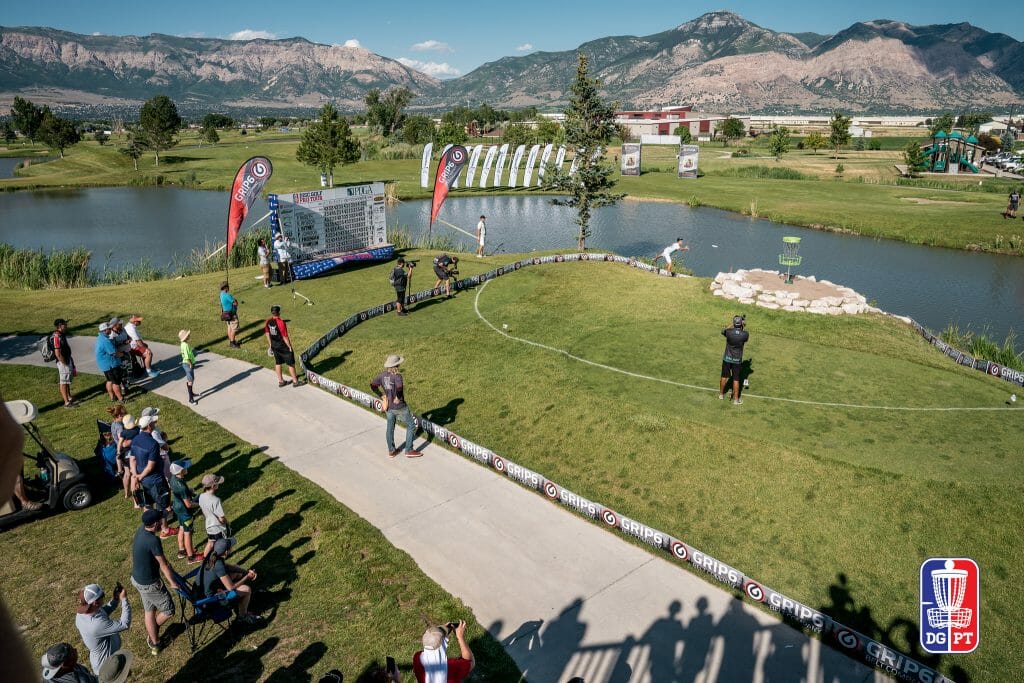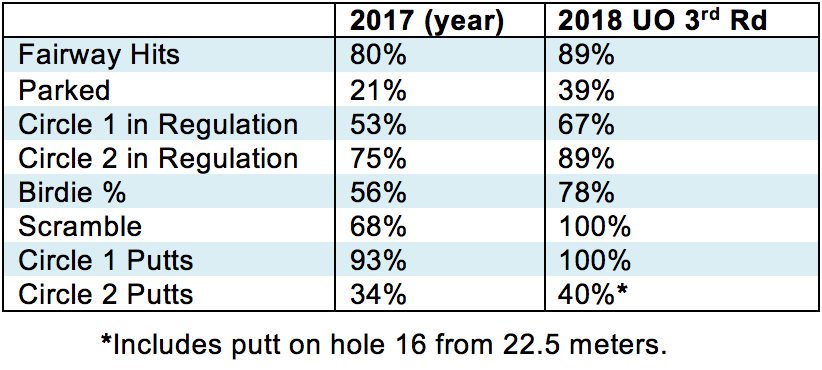A closer look at Wysocki’s unusual roadmap to victory
June 29, 2018 by Patrick Aubyrn in Analysis with 0 comments

View from the Top is a new column from Ultiworld Disc Golf examining the shots that make and break contenders at PDGA Major, National Tour, and Disc Golf Pro Tour tournaments. Here you’ll find in-depth analysis of the most recent coverage combined with historical perspective, statistics, and POV interviews with professionals and media. This week I break down Ricky Wysocki’s road to victory at the Utah Open and examine crucial moments from each round to illustrate keys to his success.
Ricky Wysocki repeated as Utah Open champion this past weekend at the Mulligan’s Creekside Disc Golf Course in Ogden, Utah. The story of the weekend was his titanic 1106-rated final round, which secured a four-stroke victory over Eagle McMahon. We expect this type of performance from Wysocki based on the lofty standards he set in 2017, but he hasn’t delivered on those expectations as often in 2018. At Mulligan’s Creekside, he needed the final round heroics to outpace strong performances from McMahon and Paul McBeth, and overcome an uneven overall performance, which included a 1064-rated 9-under par 49 on Friday and a 1008-rated 2-under par 56 on Saturday. Before we examine the shots that defined his weekend, let’s dive into the stats and put this tournament into perspective.
A Tale Of Two Seasons
A comparison of Wysocki’s 2017 and 2018 UDisc Live Stats indicates regression in most of the main statistical categories. Notably, his Fairway Hits percentage is down 10 points and his Circle 2 in Regulation percentage is down six. The only metric showing improvement is Scramble Rate, which is up six points, but this gain cannot fully cover his declining accuracy off the tee and into the green. As a result, he is scoring approximately one to two strokes worse per round. This difference is reflected in two macro-level statistics: his bogey percentage has gone up by one point from 8% in 2017 to 9% in 2018 and his rating has dropped from 1049 in June of 2017 to 1044 today.

Last weekend’s Utah Open wasn’t exactly vintage Wysocki — he succumbed to the elements during round two — but his total stats line compares favorably to his 2017 year-end totals. The most appreciable difference is C2 putting percentage: 10% below his current average, 14% below his 2017 average, and 27% (!) below his 2017 Utah Open average. However, in this case, the statistics are somewhat misleading because windy conditions on Saturday considerably impacted scoring.1 Case in point: Wysocki went 1/8 (13%) from downtown on Saturday but in rounds one and three he went a combined 2/7 (29%), officially, or 3/8 (38%) if you include this bomb from 70-plus on hole 16.
On the flip side, it’s remarkable that the other seven category totals don’t reflect the wind conditions despite significant declines compared to average: e.g. C1 in Regulation dropped 31 percentage points from Wysocki’s yearly average to 21%, and his Scramble rate declined 19 points to 57%. They remained high because Sunday proved Saturday’s remedy. His 1106-rated final round boasted impressive gains in all statistical categories, surpassing his 2017 averages. Most impressive of the bunch: 89% Fairway Hits, 89% C2 in Regulation, and 39% Parked. Wysocki’s accuracy from distance resulted in a greater number of easy scoring opportunities.

Let’s now turn our attention to the shots that separated him from the field. Additionally, I identify three key takeaways that illustrate why he emerged victorious despite dramatic swings in fortune.
Takeaway #1: Start Strong
Wysocki shot a 9-under par 49 to open the tournament and claimed sole possession of second place at day’s end, one stroke behind McBeth. His final score belied an inauspicious start. Through seven, he was 1-under par, had missed two C1 putts, and bogeyed hole 6 — the second easiest hole on the course. Three shots mark the turning point in his round, beginning with his missed putt from the drop zone. Though he carded a bogey, this was a pro miss: dead straight, in-line with the target, barely sailing above the pin. It was a course correction on earlier misses low.
On the seventh hole, his aggressive, flex-line drive flew O.B. long and right of the pin. The shot may have lacked precision, but it didn’t lack confidence. It felt like Wysocki was honing in on the form he flashed at the beginning of the round when he opened with back-to-back drop-in birdies. After watching Colten Montgomery putt from a lie near his own, he saved par with a solid C2 connection from approximately 60 feet.
These long putts seemed to boost his confidence and relax his game. Wysocki rattled off eight birdies over the course of the final 11 holes. He missed his only other C2 putt during the round but parked four of 11 holes beginning with hole 8 and was in the middle third of C1 five times. Summarized, on nine of the last 11 holes, he only attempted two putts outside of 22 feet, offering us a preview of the precision that defined his third round.
Takeaway #2: Weather the Storm
Wysocki’s 2-under par 56 second round was a poor showing compared to his first and last, but on a day that saw scoring decline across the board and McBeth card a 974-rated +2, it could have been worse. Wysocki was never over par during the course of play and saved strokes at critical moments to maintain a slim lead over McMahon, who shot a bogey-free 7-under par 51 vaulting into second place. (Were it not for McMahon’s two-stroke penalty for misplaying hole 4 on Friday, they would have been tied on Sunday.) Hole 15 perhaps best encapsulates Wysocki’s up and down play on day two.
Teeing off last, he watched Preston Johnson and McBeth throw out of bounds into the creek long of the ideal landing zone, but failed to capitalize on the wind read and followed suit. Like many of the greens at Mulligan’s Creekside, an O.B. pond lurks just behind the pin. Wysocki needed to play his left to right shot wide enough to avoid skipping into the water hazard but swing it in with enough speed to stick C1. He threw a low, forehand approach to limit the wind effect. His disc flare-skipped into the breeze, checking up on the green, and coming to rest within 20 feet of the basket. With this par save he avoided back-to-back bogeys — the only player on his card to avoid multiple holes over par during the round. Wysocki bent but didn’t break.
Takeaway #3: Bring Down the Hammer
On Sunday, McMahon and McBeth entered the round two and three strokes off the lead, respectively, and shot matching 1089-rating, 12-under par 46s. This meant the pair were hot on Wysocki’s heels, and the head-to-head battle between McMahon and Wysocki recalled the second round of the 2017 Aussie Open. That day, McMahon shot a 1097-rated 16-under par 49 only to watch Wysocki best him with an 1104-rated 17-under par 48.
In Utah, Wysocki opened up a four-stroke lead with six to play when he recorded consecutive pars for the first time that day, conceding a stroke to McMahon on hole 14. Not one to panic with a lead, Wysocki slammed the door on his competition and reeled off four consecutive birdies to end the tournament. His C2 putt on hole 17 — to an elevated basket with water in play behind the pin — secured a four-stroke lead heading into the final hole and virtually eliminated McMahon from contention.
Wysocki clearly feels comfortable on the DGPT tracks where he won last year, successfully defending his Jonesboro Open and Utah Open titles. Now the tour crosses the pond for the European swing as the next three weeks build toward the Konopiště Open, the first PDGA Major of the season. Wysocki hopes to carry his momentum into that event and secure another repeat victory.
During the second round of the 2018 Utah Open, the scoring average was 59.56, over one stroke worse than the first (58.27) and third rounds (58.34), which were virtually identical. The hot round on Saturday was a full three strokes lower than Friday, and a whopping seven strokes worse than Sunday. Especially glaring, the field recorded a meager 72 strokes under par in the wind compared to 155 on day one and 188 on day three. ↩